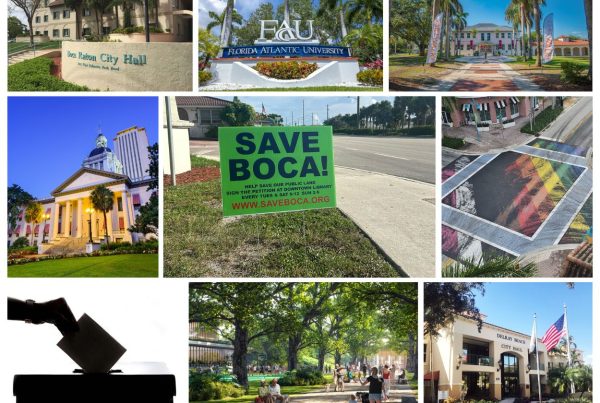New Hillstone proposal
Hillstone has sent Boca Raton a revised lease proposal for a restaurant on the Wildflower property. Not just the lease terms are new. So is the name of the restaurant.
Rather than a Houston’s, like those Hillstone operates near Town Center Mall and in Pompano Beach, Hillstone now would call the Wildflower restaurant Hillstone. Of the company’s 49 restaurants, 10 already have that eponymous label. One is in Coral Gables, and another is in Winter Park, the upscale Orlando suburb.
From the start, Boca Raton has wanted a 20-year lease on the property, which the city bought in 2009 for $7.5 million. The city proposed an initial lease payment of $500,000 a year with a 5 percent increase every five years and 5 percent of gross sales. Hillstone proposed a similar deal, but without specifying the percentage of sales. Boca Raton countered with an offer of $500,000 and a 2 percent increase every year. In November, Hillstone ended negotiations, though chief counsel Glenn Viers said the company remained willing to talk.
Hillstone now proposes fixed lease payments, rising from $600,000 during the first five years, then to $630,000, then to $661,500, and finally to $694,575 over the final five years. The company also would pay the city 5 percent of gross sales above the minimum rent. In addition, Hillstone proposes higher lease payments—from about $730,000 to nearly $900,000—over a 25-year period that would begin after the 20-year lease expires.
There are two other key points. The city would pay the restaurant’s property taxes, and the company would not build a dock for the restaurant.
The tax issue was a factor in Hillstone’s withdrawal from negotiations two months ago. Others have confirmed to me the company’s concern over not knowing what that assessment could be once the restaurant opens. Hillstone projected one figure, and then got a different one from City Manager Leif Ahnell. According to the Palm Beach County Property Appraiser’s Office, Hillstone paid about $51,000 in taxes on the Boca Houston’s site in 2015. That site is 1.3 acres. The Wildflower property is 2.3 acres.
Though Mayor Susan Haynie especially had wanted a dock—as part of Boca’s effort to make the waterfront more accessible—Hillstone said previously that its engineering consultants had advised against the structure because of difficult currents, and thus liability issues. The company says in the new proposal that it would not build the dock, so the company can “preserve water views.” The city could build one, if Hillstone agreed. Hillstone would provide a pedestrian path to the Intracoastal Waterway and six parking spaces for public access.
The city’s first lease proposal would have brought Boca Raton about $10.8 million over 20 years. The revised proposal that Hillstone rejected would have generated about $12.2 million in lease revenue. Hillstone’s new offer would mean nearly $13 million in lease payments over 20 years, though the city would have to pay the property tax. There is no way to estimate how much Boca might receive from gross sales above the lease payment.
Under any of those scenarios, Boca Raton would more than recoup the public’s investment in the property. The city also would get some of the sales tax revenue from the restaurant. What now is an eyesore would become yet another inviting destination.
Deputy City Manager George Brown has been Boca Raton’s lead negotiator on the lease. According to a city spokeswoman, Brown is “still reviewing” the new proposal. He is out of the office much of this week. Since the proposal adds 100 square feet to the restaurant, the staff must examine the effect of the increase.
“We’re committed to the deal,” Viers told me. “It’s a great location. There’s a confluence of a lot of good things happening now.” The name change, Viers said, would give the company “more flexibility” in what it offers on the Wildflower site. The Coral Gables Hillstone is the company’s top performer.
As for the added space, Viers said the company would resubmit plans with an updated review by the county’s traffic department. Viers said, however, that the company’s traffic engineer called the change “not material.”
The hope had been to get the lease on a city council agenda in January. March may be more likely. City staff has been distracted by the manufactured controversy over a 2003 memo about open space for downtown projects.
The delay is unfortunate, but there’s new reason to believe that the city and Hillstone soon can agree to a mutually beneficial deal.
New Mizner news
Nearly two years ago, Broward County-based Elad Properties proposed an oversized condo project called New Mizner on the Green for the edge of downtown Boca. The developer is back with something much smaller.
New Mizner envisioned four towers averaging more than 300 feet where rules limit development to 140 feet. Elad hired Daniel Libeskind, designer of the successor to New York’s World Trade Center. The project had a lot of glitz, but it never had a chance with the city council, despite mailers Elad sent to residents.
Elad calls the new version Mizner 200—a nine-story condo tower with 384 units (above). Mizner 200 would be applying under Ordinance 4035 and its 100-foot height limit. As before, the project would displace the 242 rental units of Mizner on the Green, which Elad also owns. The project would front Mizner Boulevard, north of Townsend Place and west of the Boca Raton Resort & Club golf course.
In a letter to the city, Elad attorney Bonnie Miskel said the design’s “gentle, undulating curves” would offer “rhythm and appropriate character” to the area. Though the project had its planning review from city staff two weeks ago, Mizner 200 still hasn’t been submitted officially. Staff members requested much more information, and suggested that the developer get a preliminary hearing before the Community Appearance Board before the required formal hearing with the panel.
There will be a technical issue with the projected size of Mizner 200. In 1988, Boca limited downtown development to 8 million square feet of “office-equivalent” space. Office development generates the most traffic. The traffic calculation for residential development is lower. So a larger project displacing a smaller one on the same site could be acceptable if the traffic calculations work.
Mizner on the Green is about 102,500 square feet. Mizner 200 would be about 161,000 square feet. City staff figure that the project is about 1,500 square feet over after the conversion from office—the most intense use for the property—to residential.
According to a statement from Elad’s CEO, the company anticipates submitting updated plans this month. “Based on the feedback” from staff, Amnon Safran said, “we are addressing all questions raised with further details/clarifications. We plan to soon meet with neighboring residents and businesses so that city staff, officials, residents and businesses and prospective buyers understand all of the benefits to be enjoyed by our pedestrian-friendly residences.”
Atlantic Crossing escapades
Nothing is easy about Atlantic Crossing.
It seemed that there might be a compromise between Delray Beach and the developers. They added back to the site plan an access road from Sixth Avenue. But a city traffic consultant found that the road would make traffic worse, not better. The city’s planning staff recommended that the Site Plan Review and Appearance Board deny the plan with the road. Last week, the board did so.
An access road had been the city commission’s preferred response to public complaints that Atlantic Crossing is not compatible with the area west of Veterans Park. City-hired traffic engineers, however, now have said the original plan is better.
Like any site plan ruling, the one on Atlantic Crossing now goes to the commission. Anyone or any entity— including the commission—can appeal the ruling. Meanwhile, Atlantic Crossing’s lawsuit against the city continues. The two sides will be in court if there’s no settlement. The developers are seeking a lot of money.
Edwards Companies is Atlantic Crossing’s developer. In a statement, Vice President Don DeVere said, “We remain willing to execute either option—the already-approved plan with ingress and egress from Northeast Sixth Avenue direct to the garage, or the modified site plan we proposed, which adds a one-way surface drive from Northeast Seventh Avenue to Northeast Sixth Avenue.
“It has been more than two years since the city approved Atlantic Crossing without a single variance or waiver. The litigation we were forced to initiate to protect our property rights after many unwarranted delays seeks damages that could reach $40 million as determined by an expert analysis – a figure that has the potential to deplete city reserves and impact taxes.
“It’s our sincere desire to avoid that outcome. We just want to move forward with this great asset to the city. We hope the city commission will work with us to reach an amicable settlement so we can finally get underway.
Duck weather news
If you’re wondering just how wet it’s been, the South Florida Water Management District reported Monday that the district’s 16 counties got 9.18 inches of rain last month— more than three times the normal amount—making it the wettest January since record-keeping began in 1932.
In addition, Jan. 22-28 was the wettest week since Tropical Storm Isaac drenched the state in August 2012. The last three months also were the wettest November-January on record. This El Nino winter is one of the soggiest. Just remember that El Nino also helped to make 2015 a mild hurricane season.
City Council salary news
Scott Singer was the only member of the Boca Raton City Council to vote against placing on the August ballot a proposal that would raise salaries for the mayor and council members. I asked Singer if he would accept the raise, despite his vote, if voters approve it.
Singer’s emailed response: “Yes, I would accept the raise only because the residents would have voted directly to approve it. I would not accept an increase if the people couldn’t have their say.” Under Boca’s charter, only the public can approve raises for the mayor and council.
About the Author
Randy Schultz was born in Hartford, Conn., and graduated from the University of Tennessee in 1974. He has lived in South Florida since then, and in Boca Raton since 1985. Schultz spent nearly 40 years in daily journalism at the Miami Herald and Palm Beach Post, most recently as editorial page editor at the Post. His wife, Shelley, is director of The Learning Network at Pine Crest School. His son, an attorney, and daughter-in-law and three grandchildren also live in Boca Raton. His daughter is a veterinarian who lives in Baltimore.








